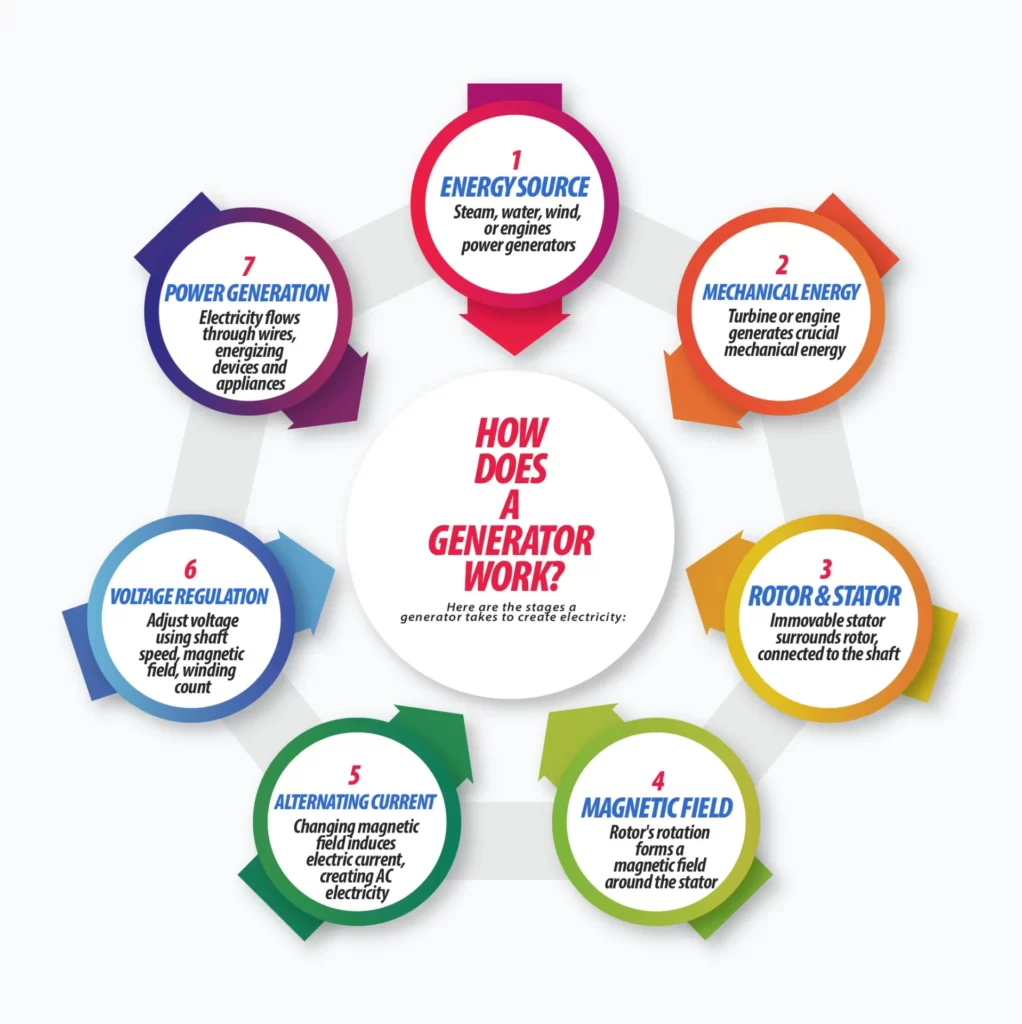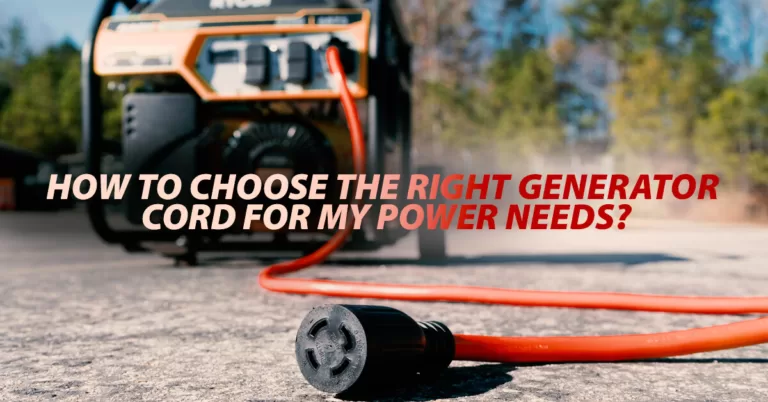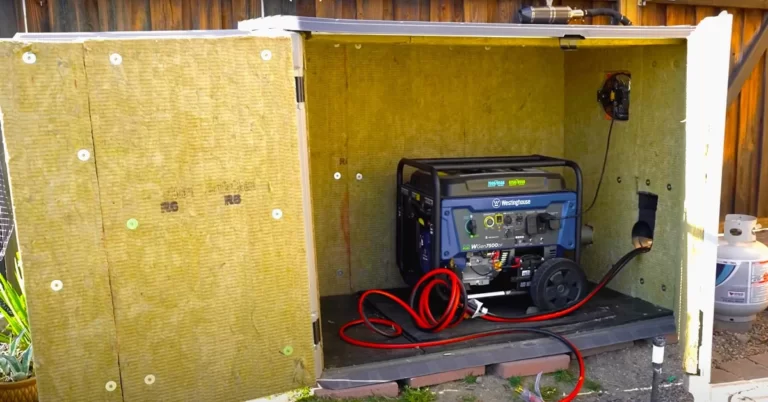How Does a Generator Work? Dig Deeper into Power
During power outages, generators provide electricity for essential appliances like fridges, AC units, TVs, phones, laptops, and even gaming consoles like Xbox. Have you ever wondered how does a generator work? Let’s delve into it. I’ll unravel the science behind generator electricity generation, rooted in Michael Faraday’s electromagnetic induction. I’ll explain how essential components like the engine, alternator, and fuel system collaborate to generate electricity.
Additionally, I’ll walk you through the step-by-step process of electricity production. Worried about electrical requirements? Don’t be; I’ll cover that too. Stay tuned for a comprehensive understanding of generators.
How Does a Generator Work and Create Electricity?
The electricity is produced by an electric generator, which converts mechanical energy from a third-party source. It doesn’t create electricity but uses mechanical energy to move electric charges through wires and create an electric current in an external circuit.
In 1831-32, Michael Faraday unveiled the principle of electromagnetic induction. This principle involves the creation of a voltage difference and the generation of electric current by moving an electrical conductor, such as a wire, within a magnetic field. Practical electricity generation requires a strong and consistent force to move the wire rapidly.
In gas-powered generators, an internal combustion engine provides this force. The engine’s motion spins an electromagnet (armature) within a stationary magnetic field (stator), generating electrical current through copper wiring.
For example, large-scale generators like those at Hoover Dam convert water turbine power into electricity. In contrast, smaller residential and commercial generators, even as of the current year, use fuels like diesel, gas, or propane to produce mechanical power for electricity generation—the electrical current powers various machines, devices, or entire electrical systems through copper wires.
Components of a Generator
Do you know how a generator and its parts work when running and producing power? If you’re curious, here are some details about the setup of different components:
Engine
The engine provides mechanical energy to the generator, determining its power output. When assessing the engine, the first things to consider are the types of fuel available, which can include diesel, gasoline, propane, or natural gas.
Smaller engines typically use gasoline, while larger ones use diesel, liquid propane, or natural gas. Some engines can run on dual fuel or a mix of diesel and gas.
Overhead Valve (OHV) engines have valves in the cylinder head, offering advantages like efficiency and power, but they’re pricier. Another aspect is the Cast Iron Sleeve (CIS) in the engine cylinder, which enhances durability and reduces wear. Most OHV engines have CIS, which is crucial for frequent or prolonged generator use. Before buying any generator, it’s essential to consult the engine to obtain complete specifications and maintenance schedules.
Alternator
The alternator, also called the ‘genhead,’ is a vital part of the generator that transforms mechanical power from the engine into electrical energy. It’s made up of stationary and moving components housed together. These parts create electricity by making magnetic and electric fields move relative to each other.
- Stator: This stationary component wraps Wire coils around an iron core.
- Rotor/Armature: This moving component produces a magnetic field via exciters, permanent magnets, or induction. The generator generates alternating current (AC) by inducing a voltage in the coils of the stator.
When assessing an alternator:
- Housing Material: Metal housing is more durable than plastic, which can deform and expose parts, increasing wear and posing hazards.
- Bearings: Ball bearings are preferable for longevity.
- Brushless Design: Alternators without brushes require less upkeep and produce cleaner power.
Fuel System
A generator’s fuel system is crucial to its functionality. The fuel tank usually holds enough for 7 to 8 hours of use. Small generators often have the tank as part of the unit, while larger ones might need an external tank/cans. Key components of the fuel system include:
- Fuel Lines: These pipes connect the tank to the engine for supplying and returning fuel.
- Ventilation: The fuel tank has a ventilation pipe to manage pressure during refilling. Avoid sparks during refilling.
- Overflow Connection: Prevents spillage during tank refilling.
- Fuel Pump: Electrically operated, it moves fuel from the main tank to a smaller day tank.
- Fuel Water Separator / Filter: Removes water and contaminants to protect the generator’s components.
- Fuel Injector: This sprays and atomizes fuel into the combustion chamber.
You must Consider these aspects, which ensure a smooth and safe fuel supply for the generator.
Voltage Regulator
The voltage regulator controls the generator’s output voltage and is a key component. It works through a cyclical process involving various components:
- Voltage Regulator: Converts a small part of AC voltage into DC. This DC goes to the exciter windings in the stator.
- Exciter Windings: These windings act like the main stator windings and create a small AC. They’re connected to rotating rectifiers.
- Rotating Rectifiers: Transform the AC from exciter windings into DC, which goes to the rotor/armature, enhancing its electromagnetic field.
- Rotor/Armature: The rotor induces a higher AC voltage across the stator windings, producing a larger output AC voltage from the generator.
This cycle mechanism repeats until the generator reaches its full output capacity. As output increases, the voltage regulator reduces DC. Once the generator reaches full capacity, the regulator maintains this level.
When you add a load to the generator, its voltage decreases slightly. The voltage regulator responds, initiating the cycle until the generator’s output returns to its initial capacity.
Cooling and Exhaust Systems
For safe and effective operation, generators’ cooling and exhaust systems are essential.
Cooling System: Continuous generator use generates heat that must be managed. Checking the coolant level is crucial, and Large or very small generators may use fresh water or hydrogen as coolants.
- Flushing the cooling system and pump after 600 hours and cleaning the heat exchanger after 2,400 hours are recommended.
Generators should be placed in well-ventilated areas with 3 feet of space on all sides per the National Electric Code.
Lubrication System
The generator’s Lubricating System is vital for its smooth and long-lasting operation. The engine’s moving parts need oil to function well and last. Oil kept in a pump lubricates the engine. Every 8 hours of operation, checking the oil level and fixing any leaks is critical. You must ensure that the lubricating oil is changed every 500 hours. Adequate lubrication is necessary to protect the generator’s internal moving parts from wear and tear, ensuring efficient and smooth functioning.
Battery Charger
The Battery Charger is a crucial component for a generator’s starting function. It keeps the generator’s battery charged by providing a precise ‘float’ voltage. If this voltage is too low, the battery remains undercharged, and its lifespan is reduced if it’s too high. Battery chargers are usually made of stainless steel to avoid corrosion. They are also totally automated and require no modifications. The appropriate float voltage for lead-acid batteries is 2.33 Volts per cell, which they deliver as their DC output voltage. This doesn’t interfere with the generator’s regular operation. Batteries start the generator, and the automatic charger ensures the battery is always prepared by providing a consistent low-level voltage.
Control Panel
The Control Panel, which houses outlets and controls, acts as the generator’s interface. It includes various features based on the manufacturer. Some common elements are:
- Electric Start and Shutdown: Auto start panels initiate the generator during power loss, monitor it, and shut it down when unnecessary.
- Engine Gauges: Gauges show oil pressure, coolant temperature, battery voltage, engine speed, and runtime. If any parameter exceeds set levels, the generator is automatically shut down.
- Generator Gauges: Meters measure output current, voltage, and frequency.
- Other Controls include phase selector, frequency switch, and engine control switch for manual or auto mode.
Control panels differ by manufacturer, but these features enhance user convenience and generator safety.
Main Assembly / Frame
The Main Assembly or Frame is a vital part of generators, providing support and grounding for safety. It’s like the visible body that holds all parts together, ensuring safe handling and protecting internal components from damage.
How Does a Generator Work to Produce Electricity: Step-by-Step Explanation
Here are the stages a generator takes to create electricity:
Energy Source:
Generators require an energy source to provide mechanical energy. This source could be steam, water, wind, or an internal combustion engine powered by fuels like gasoline or diesel.
Mechanical Energy:
The energy source drives a component, often a turbine or an engine, which rotates a shaft. This rotation generates mechanical energy.
Rotor and Stator:
Inside the generator are two main parts: the rotor and the stator. The immovable stator, which surrounds the rotor, is the component that moves and is attached to the shaft.
Magnetic Field:
The rotor’s movement creates a magnetic field around the stator. Due to the electromagnetic induction principle, the windings of the stator generate an electric current from the changing magnetic field.
Alternating Current (AC):
The induced electric current alternates in nature, changing direction periodically. This is what we commonly use in whole households as AC electricity.
Voltage Regulation:
By adjusting variables such as the spinning shaft’s speed, the intensity of the magnetic field, and the number of stator windings, the generator’s output voltage may be adjusted.
Power Generation:
The generated electricity is sent through wires to power electrical devices, machines, lights, and other appliances.

What Sets Electrical Generators Apart From Alternators?
| Property | Alternator | Generator |
|---|---|---|
| Design | Magnetic field moves, conductors remain still | Stationary field, rotating armature |
| Output | Alternating current (AC) | AC or direct current (DC) |
| Efficiency | Generally more efficient | Less efficient |
| Output Level | Higher output | Lower output |
| Energy Conservation | Uses required energy, conserves more | Uses all produced energy, conserves less |
| Polarization After Installation | Not required | Required |
| Magnetic Field | Rotating magnetic field in stator | Stationary magnetic field, spinning armature |
| Armature Movement | Stationary armature | Rotating armature |
| Input Supply | Takes input from stator | Takes input from rotor |
| RPM Range | Wide RPM range | Low RPM range |
| Voltage Generation | Produces voltage when needed | Produces voltage continuously |
| Size | Generally smaller | Larger |
| Brush Efficiency | Brushes last longer | Brushes wear out faster |
| Charging Dead Battery | Doesn’t charge a dead battery | Can charge a dead battery |
| Uses | Commonly used in vehicles to charge batteries | Used for larger-scale electricity production for home, RV, camping |
Types of Electric Generators
Electric generators come in a variety of designs that are intended for certain uses. Here are a few prevalent types:
Portable Generators:
These are like the reliable side kicks you can count on for camping trips or unexpected power outages. They offer portability and can provide essential power on the go, whether camping, in an RV, traveling in a trailer, or tailgating.
Standby Generators:
Imagine having a superhero at a rural home who responds immediately to a power outage. Standby generators are like that, ensuring your lights stay on and devices keep running.
Inverter Generators:
An inverter generator, for instance. Consider these as the tech-savvy friends supplying safe, dependable power for your sensitive devices, ensuring that your movie night or outdoor excursion is not interrupted.
Industrial Generators:
These giants are like the engines behind massive operations, from factories producing goods to construction sites powering heavy machinery.
Residential Generators:
Think of a guardian who keeps your whole house warm during storms like hurricanes emergency. Home generators keep your entire rural house powered throughout hurricane season and your refrigerator cool.
Commercial Generators:
Just like the backbone backup of businesses, these generators keep shops open, offices running, and transactions flowing smoothly.
Diesel Generators:
Reliable and efficient, diesel generators are like the workhorses of the generator world, providing steady power for critical tasks.
Gasoline Generators:
These are the go-to buddies for small-scale power needs. They’re like the handy helpers ensuring your tools and devices stay charged.
Natural Gas Generators:
Imagine having a friend who’s always there to keep things running. Natural gas power generators are like that reliable pal, providing continuous power without fuss.
Propane Generators:
Think of these generators as versatile companions that adapt to various situations. They’re like the Swiss Army knives of power generation.
Wind Turbine Generators:
These are like the eco-friendly champs that harness the wind’s energy to power remote areas, making nature a power source.
Hydroelectric Generators:
Like tapping into a river’s flow, hydroelectric generators use water’s force to create electricity, making rivers part of the energy equation.
Solar Generators:
Imagine having a friend that’s powered by the sun. Solar generators are like that, soaking up sunlight to keep your devices charged and your energy clean.
Biogas Generators:
These generators turn waste into power, becoming the eco-friendly heroes contributing to sustainable energy while managing organic waste.
Combined Heat and Power (CHP) Generators:
Think of these as the multitaskers that generate electricity and provide usable heat, making energy use efficient and practical.
Electrical Requirements for Safe Generator Use
Here are some electrical requirements that you should be aware of while using a generator to generate power:
Transfer Switch Safety
A transfer switch acts like a traffic controller, ensuring safe power distribution. It prevents overloading, isolates circuits, and keeps generator power from interfering with the grid. If you want a solid arrangement for your house, think about the Reliance Controls 31410CRK transfer switch kit.

GFCI Compatibility
Generators with GFCI outlets need a compatible transfer switch. Using the wrong one can lead to tripped outlets. Choose a switch designed for GFCI-equipped generators, like the Generac RXSW200A3.

Heavy-Duty Cords
Like power highways, heavy-duty cords connect devices to the generator. Choose cords with the right wire gauge and use them correctly. The Southwire 19178806 extension cord is a good option if you want a heavy-strength cord.

Ground Rod Usage
Using transfer switches, use ground rods instead of plugging devices directly into the generator. It’s like a grounding handshake. For larger devices, like a 240-volt air conditioner, consider a 6- or 8-gauge ground wire.

Carbon Monoxide Safety
It would help to treat generators like cars—never operate them in enclosed spaces. Keep exhaust away from the home, and for additional protection for you and your loved one, I advise you to get a Kidde Nighthawk carbon monoxide detector.

Fuel Quality and Safety
Refuel generators when they’re cool, away from heat sources. Use STA-BIL Storage Fuel Stabilizer to maintain fuel quality. After emergencies, properly empty fuel from the generator.

Weather Protection
Generators should be protected from the weather, but there should be a five-foot space to avoid overheating. For additional protection during bad weather, consider getting a Gen Tent cover.

Operational Safety
Regularly test your system as you would while preparing for a performance. Look for problems like GFCI outlets that have tripped or tripped breakers. Use trusted generator manufacturers like Honda EU2200ITAN, Champion Power Equipment 100891, Westinghouse Outdoor Power Equipment, and GENMAX Portable Inverter Generator for superior power quality.
Remember, these safety measures ensure that your generator backup keeps the lights on while keeping you and your devices safe.
FAQs
-
What is the role of the exciter in specific generators?
The exciter serves as a separate component in specific generators and generates a small electrical current to establish the magnetic field in the rotor. This magnetic field is essential for the generator’s operation. The exciter is connected to the rotor and produces a current that generates the magnetic field. Usually driven by a DC voltage source, it elevates the voltage to the required level for creating the magnetic field. The exciter might be a distinct device or integrated into the alternator itself.
-
What advantages can modern electric generators offer?
Generators have advanced with technology, offering portability through smaller, more efficient parts. Solar and wind power are two examples of alternative energy sources that are spreading over the globe. Both small and large generators are becoming more powerful, and noise-reduction features are being integrated to minimize sound pollution.
Conclusion
Electric generators, the unsung backup heroes in our lives, ensure smooth functioning, especially during blackouts and emergencies. How does a generator work? From electromagnetic induction to intricate components, they tirelessly produce the electricity we rely on. Portable generators cater to adventure needs like RVs and travel trailers, while industrial generators serve factories, both making valuable contributions. So, whether you’re watching TV during a blackout or charging your phone while camping, remember these ingenious machines are why our world stays illuminated.







